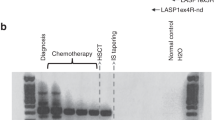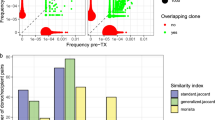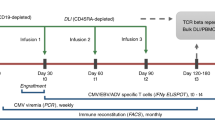Abstract
Minimal residual disease (MRD) detection using quantification of clone-specific Ig or TCR rearrangements before and after transplantation in children with high-risk ALL is an important predictor of outcome. The method and guidelines for its interpretation are very precise to avoid both false-negative and -positive results. In a group of 21 patients following transplantation, we observed detectable MRD positivities in Ig/TCR-based real-time quantitative PCR (RQ-PCR) leading to no further progression of the disease (11 of 100 (11%) total samples). We hypothesized that these positivities were mostly the result of nonspecific amplification despite the application of strict internationally agreed-upon measures. We applied two non-self-specific Ig heavy chain assays and received a similar number of positivities (20 and 15%). Nonspecific products amplified in these RQ-PCR systems differed from specific products in length and sequence. Statistical analysis proved that there was an excellent correlation of this phenomenon with B-cell regeneration in BM as measured by flow cytometry and Ig light chain-κ excision circle quantification. We conclude that although Ig/TCR quantification is a reliable method for post transplant MRD detection, isolated positivities in Ig-based RQ-PCR systems at the time of intense B-cell regeneration must be viewed with caution to avoid the wrong indication of treatment.
This is a preview of subscription content, access via your institution
Access options
Subscribe to this journal
Receive 12 print issues and online access
$259.00 per year
only $21.58 per issue
Buy this article
- Purchase on Springer Link
- Instant access to full article PDF
Prices may be subject to local taxes which are calculated during checkout






Similar content being viewed by others
References
Eckert C, Biondi A, Seeger K, Cazzaniga G, Hartmann R, Beyermann B et al. Prognostic value of minimal residual disease in relapsed childhood acute lymphoblastic leukaemia. Lancet 2001; 358: 1239–1241.
Flohr T, Schrauder A, Cazzaniga G, Panzer-Grumayer R, van der Velden V, Fischer S et al. Minimal residual disease-directed risk stratification using real-time quantitative PCR analysis of immunoglobulin and T-cell receptor gene rearrangements in the international multicenter trial AIEOP-BFM ALL 2000 for childhood acute lymphoblastic leukemia. Leukemia 2008 (in press).
Pui CH, Schrappe M, Ribeiro RC, Niemeyer CM . Childhood and adolescent lymphoid and myeloid leukemia. Hematology (Am Soc Hematol Educ Program) 2004; 2004: 118–145.
van Dongen JJ, Seriu T, Panzer-Grumayer ER, Biondi A, Pongers-Willemse MJ, Corral L et al. Prognostic value of minimal residual disease in acute lymphoblastic leukaemia in childhood. Lancet 1998; 352: 1731–1738.
Bader P, Hancock J, Kreyenberg H, Goulden NJ, Niethammer D, Oakhill A et al. Minimal residual disease (MRD) status prior to allogeneic stem cell transplantation is a powerful predictor for post-transplant outcome in children with ALL. Leukemia 2002; 16: 1668–1672.
Knechtli CJ, Goulden NJ, Hancock JP, Grandage VL, Harris EL, Garland RJ et al. Minimal residual disease status before allogeneic bone marrow transplantation is an important determinant of successful outcome for children and adolescents with acute lymphoblastic leukemia. Blood 1998; 92: 4072–4079.
Krejci O, Van der Velden V, Bader P, Kreyenberg H, Goulden N, Hancock J et al. Level of minimal residual disease prior to haematopoietic transplantation predicts prognosis in paediatric patients with acute lymphoblastic leukaemia: a report of the pre-BMT-MRD Study Group. Letter. Bone Marrow Transplant 2003; 32: 849–851.
Sramkova L, Muzikova K, Fronkova E, Krejci O, Sedlacek P, Formankova R et al. Detectable minimal residual disease before allogeneic hematopoietic stem cell transplantation predicts extremely poor prognosis in children with acute lymphoblastic leukemia. Pediatr Blood Cancer 2007; 48: 93–100.
Bader P, Beck J, Frey A, Schlegel PG, Hebarth H, Handgretinger R et al. Serial and quantitative analysis of mixed hematopoietic chimerism by PCR in patients with acute leukemias allows the prediction of relapse after allogeneic BMT. Bone Marrow Transplant 1998; 21: 487–495.
Zetterquist H, Mattsson J, Uzunel M, Nasman-Bjork I, Svenberg P, Tammik L et al. Mixed chimerism in the B cell lineage is a rapid and sensitive indicator of minimal residual disease in bone marrow transplant recipients with pre-B cell acute lymphoblastic leukemia. Bone Marrow Transplant 2000; 25: 843–851.
Sanchez J, Serrano J, Gomez P, Martinez F, Martin C, Madero L et al. Clinical value of immunological monitoring of minimal residual disease in acute lymphoblastic leukaemia after allogeneic transplantation. Br J Haematol 2002; 116: 686–694.
Radich J, Gehly G, Lee A, Avery R, Bryant E, Edmands S et al. Detection of bcr-abl transcripts in Philadelphia chromosome-positive acute lymphoblastic leukemia after marrow transplantation. Blood 1997; 89: 2602–2609.
Knechtli CJ, Goulden NJ, Hancock JP, Harris EL, Garland RJ, Jones CG et al. Minimal residual disease status as a predictor of relapse after allogeneic bone marrow transplantation for children with acute lymphoblastic leukaemia. Br J Haematol 1998; 102: 860–871.
Miglino M, Berisso G, Grasso R, Canepa L, Clavio M, Pierri I et al. Allogeneic bone marrow transplantation (BMT) for adults with acute lymphoblastic leukemia (ALL): predictive role of minimal residual disease monitoring on relapse. Bone Marrow Transplant 2002; 30: 579–585.
Radich J, Ladne P, Gooley T . Polymerase chain reaction-based detection of minimal residual disease in acute lymphoblastic leukemia predicts relapse after allogeneic BMT. Biol Blood Marrow Transplant 1995; 1: 24–31.
Uzunel M, Jaksch M, Mattsson J, Ringden O . Minimal residual disease detection after allogeneic stem cell transplantation is correlated to relapse in patients with acute lymphoblastic leukaemia. Br J Haematol 2003; 122: 788–794.
Spinelli O, Peruta B, Tosi M, Guerini V, Salvi A, Zanotti MC et al. Clearance of minimal residual disease after allogeneic stem cell transplantation and the prediction of the clinical outcome of adult patients with high-risk acute lymphoblastic leukemia. Haematologica 2007; 92: 612–618.
Bader P, Klingebiel T, Schaudt A, Theurer Mainka U, Handgretinger R, Lang P et al. Prevention of relapse in pediatric patients with acute leukemias and MDS after allogeneic SCT by early immunotherapy initiated on the basis of increasing mixed chimerism: a single center experience of 12 children. Leukemia 1999; 13: 2079–2086.
Collins Jr RH, Goldstein S, Giralt S, Levine J, Porter D, Drobyski W et al. Donor leukocyte infusions in acute lymphocytic leukemia. Bone Marrow Transplant 2000; 26: 511–516.
Dominietto A, Pozzi S, Miglino M, Albarracin F, Piaggio G, Bertolotti F et al. Donor lymphocyte infusions for the treatment of minimal residual disease in acute leukemia. Blood 2007; 109: 5063–5064.
Keil F, Kalhs P, Haas OA, Fritsch G, Reiter E, Mannhalter C et al. Relapse of Philadelphia chromosome positive acute lymphoblastic leukaemia after marrow transplantation: sustained molecular remission after early and dose-escalating infusion of donor leucocytes. Br J Haematol 1997; 97: 161–164.
Loren AW, Porter DL . Donor leukocyte infusions for the treatment of relapsed acute leukemia after allogeneic stem cell transplantation. Bone Marrow Transplant 2008; 41: 483–493.
Mehta PA, Davies SM . Allogeneic transplantation for childhood ALL. Bone Marrow Transplant 2008; 41: 133–139.
Pui CH, Jeha S . New therapeutic strategies for the treatment of acute lymphoblastic leukaemia. Nat Rev Drug Discov 2007; 6: 149–165.
Schilham MW, Balduzzi A, Bader P . Is there a role for minimal residual disease levels in the treatment of ALL patients who receive allogeneic stem cells? Bone Marrow Transplant 2005; 35 (Suppl 1): S49–S52.
Yazaki M, Andoh M, Ito T, Ohno T, Wada Y . Successful prevention of hematological relapse for a patient with Philadelphia chromosome-positive acute lymphoblastic leukemia after allogeneic bone marrow transplantation by donor leukocyte infusion. Bone Marrow Transplant 1997; 19: 393–394.
van der Velden VH, Cazzaniga G, Schrauder A, Hancock J, Bader P, Panzer-Grumayer ER et al. Analysis of minimal residual disease by Ig/TCR gene rearrangements: guidelines for interpretation of real-time quantitative PCR data. Leukemia 2007; 21: 604–611.
Pongers-Willemse MJ, Seriu T, Stolz F, d'Aniello E, Gameiro P, Pisa P et al. Primers and protocols for standardized detection of minimal residual disease in acute lymphoblastic leukemia using immunoglobulin and T cell receptor gene rearrangements and TAL1 deletions as PCR targets: report of the BIOMED-1 Concerted Action: investigation of minimal residual disease in acute leukemia. Leukemia 1999; 13: 110–118.
van Dongen JJ, Langerak AW, Bruggemann M, Evans PA, Hummel M, Lavender FL et al. Design and standardization of PCR primers and protocols for detection of clonal immunoglobulin and T-cell receptor gene recombinations in suspect lymphoproliferations: report of the BIOMED-2 Concerted Action BMH4-CT98–3936. Leukemia 2003; 17: 2257–2317.
Langerak AW, Wolvers-Tettero IL, van Gastel-Mol EJ, Oud ME, van Dongen JJ . Basic helix-loop-helix proteins E2A and HEB induce immature T-cell receptor rearrangements in nonlymphoid cells. Blood 2001; 98: 2456–2465.
van der Velden VH, Wijkhuijs JM, Jacobs DC, van Wering ER, van Dongen JJ . T cell receptor gamma gene rearrangements as targets for detection of minimal residual disease in acute lymphoblastic leukemia by real-time quantitative PCR analysis. Leukemia 2002; 16: 1372–1380.
van der Velden VH, Willemse MJ, van der Schoot CE, Hahlen K, van Wering ER, van Dongen JJ . Immunoglobulin kappa deleting element rearrangements in precursor-B acute lymphoblastic leukemia are stable targets for detection of minimal residual disease by real-time quantitative PCR. Leukemia 2002; 16: 928–936.
Verhagen OJ, Willemse MJ, Breunis WB, Wijkhuijs AJ, Jacobs DC, Joosten SA et al. Application of germline IGH probes in real-time quantitative PCR for the detection of minimal residual disease in acute lymphoblastic leukemia. Leukemia 2000; 14: 1426–1435.
Pongers Willemse MJ, Verhagen OJ, Tibbe GJ, Wijkhuijs AJ, de Haas V, Roovers E et al. Real-time quantitative PCR for the detection of minimal residual disease in acute lymphoblastic leukemia using junctional region specific TaqMan probes. Leukemia 1998; 12: 2006–2014.
Lucio P, Parreira A, van den Beemd MW, van Lochem EG, van Wering ER, Baars E et al. Flow cytometric analysis of normal B cell differentiation: a frame of reference for the detection of minimal residual disease in precursor-B-ALL. Leukemia 1999; 13: 419–427.
van Zelm MC, Szczepanski T, van der Burg M, van Dongen JJ . Replication history of B lymphocytes reveals homeostatic proliferation and extensive antigen-induced B cell expansion. J Exp Med 2007; 204: 645–655.
Cook GP, Tomlinson IM . The human immunoglobulin VH repertoire. Immunol Today 1995; 16: 237–242.
Raaphorst FM, Raman CS, Tami J, Fischbach M, Sanz I . Human Ig heavy chain CDR3 regions in adult bone marrow pre-B cells display an adult phenotype of diversity: evidence for structural selection of DH amino acid sequences. Int Immunol 1997; 9: 1503–1515.
Hazenberg MD, Verschuren MC, Hamann D, Miedema F, van Dongen JJ . T cell receptor excision circles as markers for recent thymic emigrants: basic aspects, technical approach, and guidelines for interpretation. J Mol Med 2001; 79: 631–640.
Van Der Velden VH, Hochhaus A, Cazzaniga G, Szczepanski T, Gabert J, Van Dongen JJ . Detection of minimal residual disease in hematologic malignancies by real-time quantitative PCR: principles, approaches, and laboratory aspects. Leukemia 2003; 17: 1013–1034.
van der Velden VH, Wijkhuijs JM, van Dongen JJ . Non-specific amplification of patient-specific Ig/TCR gene rearrangements depends on the time point during therapy: implications for minimal residual disease monitoring. Leukemia 2008; 22: 641–644.
Kook H, Goldman F, Padley D, Giller R, Rumelhart S, Holida M et al. Reconstruction of the immune system after unrelated or partially matched T-cell-depleted bone marrow transplantation in children: immunophenotypic analysis and factors affecting the speed of recovery. Blood 1996; 88: 1089–1097.
Storek J, Joseph A, Espino G, Dawson MA, Douek DC, Sullivan KM et al. Immunity of patients surviving 20–30 years after allogeneic or syngeneic bone marrow transplantation. Blood 2001; 98: 3505–3512.
Acknowledgements
This work was supported by MSM0021620813, MZO 00064203, MZdNR8269-3/2005, MZdNR9531-3 and GAUK 7543/2007.
Author information
Authors and Affiliations
Corresponding author
Additional information
Supplementary Information accompanies the paper on Bone Marrow Transplantation website (http://www.nature.com/bmt)
Rights and permissions
About this article
Cite this article
Fronkova, E., Muzikova, K., Mejstrikova, E. et al. B-cell reconstitution after allogeneic SCT impairs minimal residual disease monitoring in children with ALL. Bone Marrow Transplant 42, 187–196 (2008). https://doi.org/10.1038/bmt.2008.122
Received:
Revised:
Accepted:
Published:
Issue Date:
DOI: https://doi.org/10.1038/bmt.2008.122
Keywords
This article is cited by
-
Intensive monitoring of minimal residual disease and chimerism after allogeneic hematopoietic stem cell transplantation for acute leukemia in children
Bone Marrow Transplantation (2021)
-
Minimal residual disease assessment by next-generation sequencing. Better tools to gaze into the crystal ball?
Bone Marrow Transplantation (2017)
-
Next-generation sequencing indicates false-positive MRD results and better predicts prognosis after SCT in patients with childhood ALL
Bone Marrow Transplantation (2017)
-
Is Next-Generation Sequencing the way to go for Residual Disease Monitoring in Acute Lymphoblastic Leukemia?
Molecular Diagnosis & Therapy (2017)
-
Minimal Residual Disease Monitoring in Adult ALL to Determine Therapy
Current Hematologic Malignancy Reports (2015)



